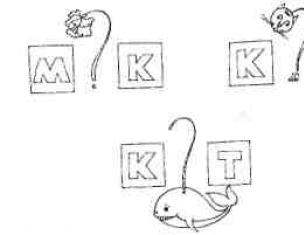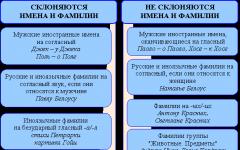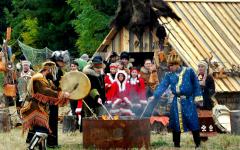The armored train "Zheleznyakov" during the defense of Sevastopol in 1941-42 became a nightmare for the Germans, who nicknamed it the "Green Ghost". For Soviet people he became a legend, an example of the success of careful calculation of combat operations and the desperate heroism of the crew.
Not far from the Sevastopol bus station, on Revyakin Square, there is a monument to the most famous Crimean steam locomotive, the hero of the Great Patriotic War, the armored train “Zheleznyakov”. Not a single tourist passes by without taking a few pictures of this colorful train from the El-2500 steam locomotive with the inscription “Death to fascism!” and a TM-1-180 gun transporter equipped with an impressive B-1-P cannon. The most uncultured guests of the city immediately begin to climb on the roof and mechanisms of the locomotive, not noticing the signs: “The locomotive is a veteran of war and labor. Handed over forever to the hero city of Sevastopol by the Crimean railway workers" and "The steam locomotive of the legendary armored train "Zheleznyakov", which took an active part in the heroic defense of Sevastopol in 1941-1942." After all, a veteran of war and labor, even though he is a locomotive, deserves special respect.
It is necessary to clarify that the monument to “Zheleznyakov” is not the legendary armored train itself, but a similar locomotive with a conveyor, which has nothing to do with the history of the hero train. Historical authenticity in its appearance is not observed, but the monument fulfills its role, being a constant reminder of the legendary “Green Ghost”.
In total, during the attack on the Crimea by Manstein’s 11th Army, 7 armored trains were put into operation. There was a severe shortage of armored vehicles on the peninsula, and therefore land battleships, familiar from the Civil War, were hastily built in railway workshops and ship repair yards. The remains of the ship's armor and existing weapons were used. Unfortunately, all Crimean armored trains were quickly destroyed by the Nazis; only Zheleznyakov managed to conduct fighting- from November 7, 1941 to June 28, 1942, making 140 raids and causing significant damage to the enemy.
Armored train No. 5 of the Coastal Defense of the Main Base of the Black Sea Fleet "Zheleznyakov" was put into operation on November 4 in already besieged Sevastopol; the commander of the Black Sea Fleet and members of the Military Council were at its opening ceremony. The armored train was built by workers of the Sevastopol Marine Plant with the active help of surviving sailors from the crews of other armored trains. Platforms for 60-ton wagons were used, onto which steel sheets were welded and reinforced with reinforced concrete, resulting in composite armor. The weapons included 15 machine guns, 5 76 mm guns, and 8 mortars were located on a special site. A second locomotive was also added, which significantly increased the train's maneuverability.
Zheleznyakov carried out its first combat mission on November 7 in the area of the village of Duvankoy (now Verkhnesadovoe): a battery was suppressed and enemy infantry was fired upon.
The successful survival of the Sevastopol armored train depended on many factors. His team skillfully used the local terrain with many narrow ravines, cliffs and tunnels when maneuvering. “Zheleznyakov” struck with lightning speed at targets that the marines were reconnaissance and disappeared before enemy artillery could shoot it or track down bombers. The Germans nicknamed it the “Green Ghost” for its unusually effective camouflage paint job, which the crew continually changed, distorting the outline of the armored train beyond recognition, making it visually indistinguishable from the terrain. Also, the success of Zheleznyakov’s operations was ensured by the handcar, which checked and repaired the tracks.
During the repulsion of the second assault on Sevastopol on December 17, the armored train supported the defenders of the city, traveling towards the advancing German troops, firing from mortars and 12 machine guns. The train was covered by machine gunners from the 8th brigade. Marines. The restoration team, led by road foreman Nikitin, repaired the road around the clock, often under fire.
At the end of 1941, Zheleznyakov visited the Sevastopol rear for repairs and rearmament. Three new machine guns were installed, one old 76-mm gun was replaced with two new automatic cannons, and four 82-mm mortars were replaced with three 120-mm regimental mortars.
The “green ghost” was almost destroyed during the battles for the Mekenzi Mountains. German heavy artillery bombed the track right in front of the armored train, ballast platforms flew off the slope, and one of the armored platforms went off the rails. The main locomotive was disabled by shell fragments, and the second one did not have enough power to drag the armored platform onto the rails. Heroic deed carried out by Evgeny Matyush, an assistant driver, he climbed into the firebox filled with raw coal and, immediately poured with evaporating water, made repairs. The train was saved, and Matyush immediately lost consciousness from numerous burns.
After the Mekenzievy Gory station was captured by the enemy on December 22, an armored train made a daring attack on it. Having literally burst into the Zheleznyakov station, he began shooting at the equipment almost point-blank and manpower enemy. The armored train also took part in a desperate operation to deliver new barrels to the 30th battery to replace worn ones.
The Nazis managed to significantly damage the elusive train on December 29 during an air raid; many crew members were killed, but the survivors were able to shoot back, using machine guns as anti-aircraft guns. In the same way, with the help of 18 machine gun barrels, on January 1, 1942, two enemy fighters were shot down.
It is not surprising that the Nazis hated Zheleznyakov, because in the winter of 1942 alone, the armored train destroyed about 1,500 enemy soldiers, 3 vehicles, 10 wagons with cargo, 6 dugouts, 9 bunkers, 13 machine gun nests, and a heavy battery. In mid-June, an armored train disabled 3 German tanks when it entered into battle with a column of armored vehicles.
By the end of June 1942, “Zheleznyakov” remained the only powerful artillery unit on the northern side of Sevastopol; the paint was literally peeling off its barrels, they were so hot from the shooting. The armored train was hunted with the help of dozens of enemy aircraft.
On June 26, the “Green Ghost” gave its last Stand- there were 50 bombers against him. One of the entrances to the Trinity Tunnel was collapsed by massive bombing, the second platform was blocked, but the train escaped from the tunnel and opened fire on the enemies. It was possible to completely block the armored train only the next day, by filling up the second entrance to the tunnel. The remnants of the crew fought until July 3. This is how the story of the Soviet “Zheleznyakov” ended...
...And the story of the German armored train “Eugen” began. The Nazis unearthed the legendary train, repaired it and used it, equipping it with 105 mm howitzers. Eugen was blown up by the Germans in 1944 during the Soviet offensive.
According to legend, the Zheleznyakova-Eugen steam locomotive was repaired after the war and drove trains around Crimea for a long time. On October 24, 1967, he was delivered from Dzhankoy to Sevastopol by a former front-line brigade, which included driver M. Galanin, fireman V. Ivanov and the same driver’s assistant E. Matyush.
War is hard work! Not only for a living soldier, but also for inanimate equipment. For tanks, ships, guns, airplanes, which are built only to help a warrior defend his life and homeland. Even in history lessons we were told that during the Great Patriotic War 1941-1945 A huge number of Russian soldiers and ordinary citizens from children to old men showed their courage, heroism and dedication. But, if you think about it, there are people without weapons and equipment? Equipment that throughout the war also faithfully served the cause of defending the Motherland from the enemy. It is difficult to count the number of such armored soldiers of that terrible war. It is about one of the “steel heroes” that our conversation will go. This is the Zheleznyakov armored train.
Armored trains showed excellent performance back in the years Civil War in Russia. They were a means of transportation for people and transportation of weapons, provided fire support and escort, served as hospitals and delivered food to troops. When in 1941 Soviet Union the fascists attacked, immediately capturing many of our cities, and the shortage military equipment turned out to be an obvious fact, it was decided to put armored trains back into service. In the fall of 1941, the Zheleznyakov armored train was built at the shipyard in Sevastopol, on which the command had high hopes. And it must be said that he subsequently fully justified these hopes.
Since Sevastopol is a port city, a crew of Black Sea Fleet sailors was recruited for combat service on the armored train. The basis of the armored train was ordinary railway platforms, onto which workers welded armor plates using electric welding and additionally reinforced them with concrete. The entire train was pulled by a high-power locomotive. “Zheleznyakov” was armed, as they say, “to the teeth”: four naval artillery guns, six mortars, fourteen machine guns. Captain G. Sahakyan was appointed the first commander of the armored train, and on November 7, 1942, the armored train began its first combat mission. Throughout its service, Zheleznyakov completed more than one hundred and forty combat raids. He supported our infantry with cannon and machine gun fire, entered into open battle with tanks, suppressed German artillery batteries, and shot down their planes. Always being at the forefront of the attack, the armored train inflicted enormous damage on enemy forces, sowing terrible panic in the enemy camp. The Germans had no choice but to start hunting for the armored giant, which they dubbed the “Green Ghost” for its speed and elusiveness. The title was right on point. For many months, German pilots tried in vain to track down the armored train and destroy it. Each time, the heavy but nimble train took refuge in the tunnels, only angering the enemy even more.
However, in the summer of 1942, the armored train was still ambushed. During the last and most difficult battles for Sevastopol, the Nazis collapsed the arches of the Trinity Tunnel over the train, but the surviving sailors of the Green Ghost, picking up machine guns from the armored train, selflessly fought the enemy until the last drop of blood for several more days. Unfortunately, they were unable to repel the attack and the train fell into the hands of the enemy. The Germans brought it into working order and called it "Ogein". Now the German armored train was fighting with Soviet army until in 1944, when retreating from the city, the Nazis blew it up on the territory of the station.
When the war ended, the locomotive that drove the Green Ghost was restored and began to serve peaceful purposes. Now it has been turned into a small museum - one of the attractions of the city of Sevastopol. A memorial plaque with photographs of those distant times, which was installed next to the locomotive, tells us about past exploits and glorious victories of armored heroes.
Armored train "Zheleznyakov" - armored train No. 5 of the Coastal Defense of the Main Base of the Black Sea Fleet "Zheleznyakov", nicknamed by the Germans "Green Ghost", built on November 4, 1941 at the Sevastopol Marine Plant. The armored train managed to conduct combat operations - from November 7, 1941 to June 28, 1942, making 140 raids and causing significant damage to the enemy.
In a small area of besieged Sevastopol, an armored train could “survive” only thanks to speed and stealth. Each Zheleznyakov raid was carefully planned. In front of the armored train, a handcar always came to the position to check the condition of the railway tracks.
The Germans made many attempts to suppress the armored train. The railway track was targeted with heavy artillery, and a spotter aircraft was constantly on duty over the road. But neither artillery nor aviation managed to inflict serious damage on the armored train. According to the testimony of prisoners, German soldiers They called the elusive armored train the “green ghost.”
In 1941-1942, the armored train made more than 140 combat missions. Only from January 7 to March 1, 1942, “Zheleznyakov,” according to the command of the Sevastopol defensive regions, destroyed nine bunkers, thirteen machine gun nests, six dugouts, one heavy battery, three aircraft, three vehicles, ten wagons with cargo, up to one and a half thousand soldiers and enemy officers.
On June 15, 1942, Zheleznyakov entered into battle with a convoy German tanks, knocking out at least 3 armored vehicles.
June 21 departing to Sevastopol Bay The city’s defenders blew up all the remaining artillery on the North Side. The only powerful artillery unit left was the armored train, which was now based in the Trinity Tunnel. “Zheleznyakov” fired at German units on the North Side until the paint on the gun barrels began to burn.
German aircraft collapsed the entrance to the tunnel several times. On June 26, 1942, more than 50 enemy bombers launched a powerful attack on the Trinity Tunnel. A multi-ton boulder fell on the 2nd armored platform. They managed to pull out part of the crew through the landing hatches in the floor of the car, then the rails burst, and the armored platform piled up with blocks was pressed to the bottom of the tunnel.
On June 28, 1942, German aircraft collapsed the last exit from the tunnel. The armored train was killed, but its crew still fought, installing several mortars in the area of the state district power plant. The remnants of the crew fought until July 3.
Terentyev Andrey
On November 4, in already besieged Sevastopol, the construction of armored train No. 5 of the Coastal Defense of the Main Base of the Black Sea Fleet “Zheleznyakov” was completed, which was destined to go down in history as the “Green Ghost”. Workers of the Sevastopol Marine Plant, together with sailors from the crews of broken armored trains, built steel sheets onto ordinary platforms for 60-ton cars, sewing them together with electric welding and strengthening them with reinforced concrete pouring (a prototype of composite armor). Five 76-mm guns were installed on the armored platforms (three universal 34-K ship mounted mounts with 76.2-mm guns, two 76.2-mm anti-aircraft guns model 1902/1930), and 15 machine guns. The armored train had a special platform with 6, according to other sources, 8 mortars. To increase speed, in addition to an armored locomotive, the train was given a powerful locomotive. Captain Sahakyan was appointed commander of the armored train.
On November 7, 1941, Zheleznyakov went on its first combat mission. Moving beyond the Kamyshlovsky Bridge, the armored train fired at a concentration of enemy infantry near the village of Duvankoy (present-day Verkhnesadovoe) and suppressed a battery on the opposite slope of the Belbek Valley.
In a small area of besieged Sevastopol, an armored train could “survive” only thanks to speed and stealth. Each Zheleznyakov raid was carefully planned. In front of the armored train, a handcar always came to the position to check the condition of the railway tracks. After a swift artillery and mortar strike on targets previously reconnoitered by the Marines, the train quickly left for areas where Railway took place in narrow recesses carved into rocks, or into tunnels, before the Germans had time to shoot with artillery or raise aircraft. The Germans made many attempts to suppress the armored train. The railway track was targeted with heavy artillery, and a spotter aircraft was constantly on duty over the road. But neither artillery nor aviation managed to inflict serious damage on the armored train. According to the testimony of prisoners, German soldiers called the elusive armored train the “green ghost.”
A month later, due to Sahakyan’s injury, Lieutenant Tchaikovsky took command of the armored train. Later, the armored train was commanded by engineer-captain M.F. Kharchenko.
Commander of "Zheleznyakov" Captain M.F. Kharchenko
On December 17, 1941, the second assault on Sevastopol began. "Zheleznyakov" supported the marines of the 8th brigade and units of the 95th rifle division. The armored train literally came out to meet the advancing German units, firing not only with mortars, but also with all machine guns. By order of the commander, soldiers with personal small arms and grenades were placed at converted control sites in front of the armored train.
A special restoration team of road master Nikitin was assigned to the armored train, which restored the damaged railway track almost every day under enemy fire. Understanding perfectly the cost of Zheleznyakov’s attacks, the commander of the 8th brigade Marine Corps Vilshansky specially allocated machine gunners to cover the firing positions of the armored train.
“The armored train changed its appearance all the time. Under the leadership of Junior Lieutenant Kamornik, the sailors tirelessly painted armored platforms and locomotives with stripes and camouflage patterns so that the train blends indistinguishably with the terrain. The armored train skillfully maneuvered between excavations and tunnels. To confuse the enemy, we constantly change parking places. Our mobile rear is also constantly on the move,” recalled the foreman of a group of machine gunners on an armored train, midshipman N.I. Alexandrov.
“Zheleznyakov” operated not only in the Mekenziev Mountains region, but also reached the Balaklava railway line, where German troops rushed to Sapun Mountain. The command of the Sevastopol defensive region greatly appreciated the Zhelaznyakov. When, during the departure of the train from a combat position, the track was broken, and the armored train found itself under attack from German artillery, which was aimed by a spotter aircraft, a flight of Soviet fighters was sent to its rescue; it was very risky to lift them from the Chersonesos airfield, given the complete dominance of German aviation in the skies. .
At the end of 1941, the armored train was sent to the rear for repairs. Some of the new weapons were placed on the armored platforms. One of the old guns was replaced with two new automatic cannons (a total of 5 34-K installations with 76.2-mm guns, and 1 76-mm anti-aircraft gun model 1902/1930). Instead of four 82-mm mortars, three regimental 120-mm mortars were installed (7 mortars in total). They also installed 3 new machine guns, bringing their number to 18.
On December 22, when German troops captured the village and station of Mekenzievy Gory, an armored train burst straight into the station and opened fire at point-blank range on a concentration of enemy soldiers and equipment. “Zheleznyakov” also covered a daring operation to deliver new gun barrels to the legendary 30th battery.
“How the Germans hated this armored train, and how many kind, full of gratitude words were spoken to it by our soldiers and commanders,” Colonel I. F. Khomich, a participant in the defense of Sevastopol, later wrote. - Sailors worked on the armored train. The courage of the Black Sea people has long been proverbial. The armored train actually flew at the enemy and fired with such rapid surprise, as if it were running not on rails, but right along the uneven ground of the peninsula.”
German aviation was constantly hunting for the last Crimean armored train (a total of 5 armored trains were built in Crimea, but 4 of them were lost in battles during the defense of the peninsula in October-November 1941), which caused them so many problems. On the night of December 28-29, 1941, the crew of an armored train set aside for rest placed the train not in a tunnel, but under a sheer rock at the Inkerman station, fitting passenger cars for rest between the rock and the armored train. The Germans took advantage of this by launching an airstrike that cost the lives of many Zheleznyakovites.
But in battle, the 5 guns and machine guns of the armored train were a serious opponent for aviation. So, only on the first day of 1942, Zheleznyakov’s crews shot down two German fighters who decided to fire at the stopped train.
During the battles for the Mekenzie Mountains, German heavy artillery managed to defeat railway track in front of a moving armored train. Ballast platforms went downhill and an armored platform derailed. The fragments of the next shell disabled the main locomotive, and the power of the second armored locomotive was not enough to lift the armored platform onto the rails. The armored train was saved by assistant driver Evgeniy Matyush. To repair the locomotive, he climbed into a furnace filled with raw coal. The water that was poured on the daredevil immediately evaporated. Having finished his work, Matyush barely managed to get out and lost consciousness from his burns. Thanks to his feat, it was possible to put the locomotive into operation, lift the armored platform onto the rails and remove the train from the attack of heavy enemy batteries.
Soon, coal reserves in Sevastopol came to an end. Several times the Zheleznyakovites managed to remove coal literally from under the enemy’s nose - from the Mekenzievy Gory station, which changed hands. When this coal ran out, driver Galinin proposed making special briquettes from coal dust and tar. This idea turned out to be quite viable, and coal dust was collected on the territory of the railway station and throughout Sevastopol.
The actions of the Zheleznyakov armored train were very effective. During almost the entire defense of Sevastopol in conditions of positional defense, Zheleznyakov carried out more than 140 raids. From the available data, only in the period from January 7 to March 1, 1942, the armored train carried out 70 combat raids and destroyed: 9 pillboxes, 13 machine gun nests, 1 heavy battery, 3 cars, 3 aircraft, about 1,500 enemy soldiers and officers. And on June 15, 1942, “Zheleznyakov” entered into battle with a column of German tanks, knocking out at least 3 armored vehicles.
On June 21, the defenders of the city retreating to Sevastopol Bay blew up all the remaining artillery on the Northern side. The only powerful artillery unit left was the armored train, which was now based in the Trinity Tunnel. “Zheleznyakov” fired at German units on the North Side until the paint on the gun barrels began to burn.
German aircraft collapsed the entrance to the tunnel several times. On June 26, 1942, more than 50 enemy bombers launched a powerful attack on the Trinity Tunnel. A multi-ton boulder fell on the 2nd armored platform. They managed to pull out part of the crew through the landing hatches in the floor of the car, then the rails burst, and the armored platform piled up with blocks was pressed to the bottom of the tunnel.
The second exit from the tunnel remained free, the locomotive brought out the surviving armored platform, which again opened fire on the enemy. Buried under the rock, the Green Ghost struck its final blow.
The next day, German aircraft collapsed the last exit from the tunnel. The armored train was lost, but its crew still fought. The surviving Zheleznyakovites, having removed their machine guns, continued to fight the enemy in the Kilen-balka area and installed several mortars in the area of the state district power station.
On June 30, the remains of the crew were blocked in a half-buried tunnel. The Germans, having sent out a truce, asked the civilians hiding here from the bombing to leave the tunnel. Armored train nurses were sent with them. The Zheleznyakovites held out in the tunnel until July 3. Only a few survivors were captured.
Trinity Tunnel, early 20th century
In the early 90s, a TM-1-180 railway artillery mount was placed next to the locomotive, which actively participated in hostilities as part of the 16th separate railway artillery battery of coastal defense Black Sea Fleet. And which is now mistaken for one of the armored platforms of the legendary Zheleznyakov armored train. But this weapon was not part of the Zheleznyakov armored train.
Rudenko-Minikh Igor
P.S. In general, “Zheleznyakov” is a unique armored train. The Ertz is the most powerful thing in the world, but at the same time it is conceptually an ideal armored train. Cheap and at the same time extremely effective protection made of composite material provided reliable protection. Two trains made it possible to quickly change position and get out of the fire. But most importantly, it was the only armored train with almost completely universal weapons. Allowing extremely effective combat against ground targets. And at the same time create enough problems for the air enemy. And the availability large quantity mortars, did not leave any dead zones for the enemy. Not accessible to destruction from an armored train.
Armored train "Zheleznyakov" - armored train No. 5 of the Coastal Defense of the Main Base of the Black Sea Fleet "Zheleznyakov", nicknamed by the Germans "Green Ghost", built on November 4, 1941 at the Sevastopol Marine Plant. The armored train managed to conduct combat...
Armored train "Zheleznyakov" - armored train No. 5 of the Coastal Defense of the Main Base of the Black Sea Fleet "Zheleznyakov", nicknamed by the Germans "Green Ghost", built on November 4, 1941 at the Sevastopol Marine Plant. The armored train managed to conduct combat operations - from November 7, 1941 to June 28, 1942, making 140 raids and inflicting significant damage to the enemy.
In a small area of besieged Sevastopol, an armored train could “survive” only thanks to speed and stealth. Each Zheleznyakov raid was carefully planned. In front of the armored train, a handcar always came to the position to check the condition of the railway tracks.
The Germans made many attempts to suppress the armored train. The railway track was targeted with heavy artillery, and a spotter aircraft was constantly on duty over the road. But neither artillery nor aviation managed to inflict serious damage on the armored train. According to the testimony of prisoners, German soldiers called the elusive armored train the “green ghost.”

In 1941-1942, the armored train made more than 140 combat missions. Only from January 7 to March 1, 1942, “Zheleznyakov,” according to the command of the Sevastopol defensive regions, destroyed nine bunkers, thirteen machine gun nests, six dugouts, one heavy battery, three aircraft, three vehicles, ten wagons with cargo, up to one and a half thousand soldiers and enemy officers.
On June 15, 1942, Zheleznyakov entered battle with a column of German tanks, knocking out at least 3 armored vehicles.
On June 21, the defenders of the city retreating to Sevastopol Bay blew up all the remaining artillery on the Northern side. The only powerful artillery unit left was the armored train, which was now based in the Trinity Tunnel. “Zheleznyakov” fired at German units on the North Side until the paint on the gun barrels began to burn.

German aircraft collapsed the entrance to the tunnel several times. On June 26, 1942, more than 50 enemy bombers launched a powerful attack on the Trinity Tunnel. A multi-ton boulder fell on the 2nd armored platform. They managed to pull out part of the crew through the landing hatches in the floor of the car, then the rails burst, and the armored platform piled up with blocks was pressed to the bottom of the tunnel.
On June 28, 1942, German aircraft collapsed the last exit from the tunnel. The armored train was killed, but its crew still fought, installing several mortars in the area of the state district power plant. The remnants of the crew fought until July 3.








